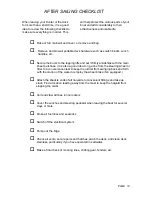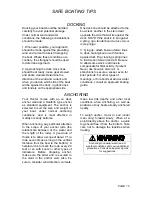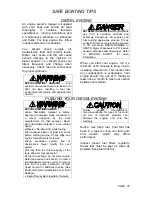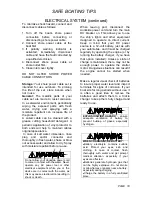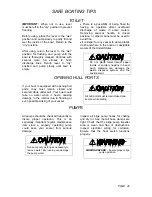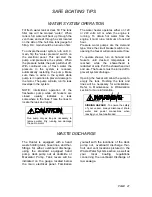
GLOSSARY OF SAILING TERMS
PAGE 6
Drift:
1, to float with the current or
wind; 2, US the speed of a current
(rate UK); 3, UK: the distance a boat
is carried by a current in a given time.
Drogue:
a sea anchor put over the
stern of a boat or life raft to retard
drift
.
Drop keel:
a retractable
keel
which
can be drawn into the hull, when
entering
shallow
waters
and
recovering on to a trailer.
E
Eye of the wind:
direction from which
the true wind blows.
F
Fair:
well-faired line or surface is
smoother with no bumps, hollows or
abrupt changes in directions.
Fairlead:
a fitting through which a line
is run to alter the lead of the line.
Fathom:
the measurement used for
depths of water and lengths or rope. 1
fathom = 6 ft. or 1.83m.
Fid:
a tapered tool used for
splicing
heavy rope and for sail-making, often
hollow.
Fiddle:
a raised border for a cabin
table, chart table etc., to prevent
objects falling off when the boat
heels
.
Fix:
the position of the vessel as
plotted from two or more position
lines.
Forestay:
the foremost stay, running
from the masthead to the stemhead,
to which the headsail is hanked.
Freeboard:
vertical distance between
the
waterline
and the top of the deck.
G
Genoa:
a large headsail, in various
sizes, which overlaps the mainsail and
is hoisted in light to fresh winds on all
points of
sailing.
Gimbals:
two
concentric
rings,
pivoted at right angles, which keeps
objects horizontal despite the boat
’
s
motion, e. g. compass and cooker.
Go about:
to turn the boat through the
eye of the wind
to change tack.
Gooseneck:
the fitting attaching the
boom to the mast, allowing it to move
in all directions.
Goosewing:
to boom-out the headsail
to windward on a run by using a
whisker pole
to hold the sail on the
opposite side to the mainsail.
Ground tackle:
general term used for
anchoring gear.
Guard rail:
a metal rail fitted around
the boat to prevent the crew falling
overboard.
Gudgeon:
a rudder fitting. It is the eye
into which the
pintle
fits.
Guy:
a steadying rope for a spar; a
spinnaker guy controls the fore and aft
position of the spinnaker pole; the
foreguy holds the spinnaker pole
forward and down.
Gybe:
to change from one
tack
to
another by turning the stern through
the wind.
H
Halyard:
rope used to hoist and lower
sails.
Hank:
fitting used to attach the
luff
of
a sail to a stay.
Hatch:
an opening in the deck giving
access to the interior.
Hawes pipe:
see
Navel pipe
.
Head-topwind:
when the bows are
pointing right into the wind.
Headfoil:
a streamlined surround to a
forestay
, with a groove into which a
headsail
luff
slides.
Heads:
the toilet.
Headway:
the forward movement of a
boat through the water.
Heave-to:
to
back
the jib and lash the
tiller to
leeward
; used in heavy
weather to encourage the boat to lie
quietly and to reduce
headway.
Heaving line:
a light line suitable for
throwing ashore.
Heel:
to lean over to one side.
I
Isobars:
lines on a weather map
joining places of equal atmospheric
pressure.
J
Jackstay:
a line running fore and aft,
on both sides of the boat, to which
safety harnesses are clipped.
Jury:
a temporary device to replace
lost or damaged gear.
K
Keel:
the main backbone of the boat
to which a
ballast keel
is bolted or
through
which
the
centerboard
passes.
Kicking strap:
a line used to pull the
boom down, to keep it horizontal,
particularly on a reach or run.
L
Lanyard:
a short line attached to one
object, such as a knife, with which it is
secured to another.
Leech:
1, the after edge of a triangle
sail; 2, both side edges of a square
sail.
Leehelm:
the tendency of a boat to
bear away from the wind.
Lee shore:
a shore on to which the
wind blows.
Leeward:
away from the wind; the
direction to which the wind blows.
Leeway:
the sideways movement of a
boat off its
course
as a result of the
wind blowing on one side of the sails.
Lifeline:
a wire or rope rigged around
the deck to prevent the crew falling
overboard.
Limber holes:
gaps left at the lower
end of frames above the
keel
to allow
water to drain to the lowest point of
the
bilges
.
List:
a boat
’
s more or less permanent
lean to one side, owing to the
improper distribution of weight, e.g.,
ballast
or water.
Log:
1, an instrument for measuring a
boat
’
s speed and distance traveled
through the water; 2, to record in a
book the details of a voyage, usually
distances covered and weather.
Luff:
the forward edge of a sail. To luff
up is to turn a boat
’
s head right into
the wind.
Luff groove:
a groove in a wooden or
metal spar into which the
luff
of a
headsail is fed.
Lurch:
the sudden roll of a boat.
M
Marlin spike:
a pointed steel or
wooden spike used to open up the
strands of rope or wire then splicing.
Mast Step:
the socket in which the
base of the mast is located.
Measured mile:
a distance of one
nautical mile measured between
buoys or
transits/ranges
ashore, and
marked on the chart.
Summary of Contents for sailing yacht
Page 28: ......
Page 39: ......
Page 40: ......
Page 41: ......
Page 43: ......
Page 46: ......
Page 47: ......
Page 48: ......
Page 49: ......
Page 50: ......
Page 51: ......
Page 52: ......
Page 53: ......
Page 54: ......
Page 55: ......
Page 56: ......
Page 57: ......
Page 58: ......
Page 59: ......
Page 62: ......
Page 63: ......
Page 64: ......
Page 65: ......
Page 67: ......
Page 68: ......
Page 69: ......
Page 70: ......
Page 71: ......
Page 74: ......
Page 77: ......
Page 78: ......
Page 79: ......
Page 80: ......
Page 81: ......
Page 82: ......
Page 83: ......
Page 84: ......
Page 85: ......
Page 86: ......
Page 87: ......
Page 88: ......
Page 89: ......
Page 90: ......
Page 91: ......
Page 92: ......
Page 93: ......
Page 94: ......
Page 95: ......
Page 96: ......
Page 97: ......
Page 98: ......
Page 99: ......
Page 100: ......
Page 101: ......
Page 102: ......
Page 103: ......
Page 104: ......
Page 105: ......
Page 106: ......
Page 107: ......
Page 108: ......
Page 109: ......
Page 110: ......
Page 111: ......
Page 112: ......
Page 113: ......
Page 117: ......
Page 118: ......
Page 119: ......
Page 122: ......
Page 123: ......
Page 124: ......
Page 129: ......
Page 130: ......
Page 131: ......
Page 132: ......
Page 133: ......
Page 134: ......
Page 135: ......
Page 136: ......
Page 137: ......
Page 138: ......
Page 139: ......
Page 140: ......
Page 141: ......
Page 142: ......
Page 143: ......
Page 144: ......
Page 145: ......
Page 146: ......
Page 147: ......
Page 148: ......
Page 149: ......
Page 150: ......
Page 151: ......
Page 152: ......
Page 153: ......
Page 154: ......
Page 155: ......
Page 156: ......
Page 157: ......
Page 158: ......
Page 159: ......
Page 160: ......
Page 161: ......
Page 162: ......
Page 163: ......
Page 164: ......
Page 165: ......
Page 166: ......
Page 167: ......
Page 168: ......
Page 169: ......
Page 170: ......
Page 171: ......
Page 174: ......
Page 175: ......
Page 176: ......
Page 177: ......
Page 178: ......
Page 179: ......
Page 180: ......

















